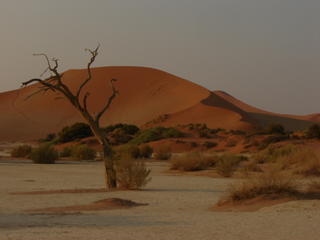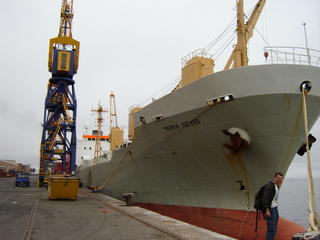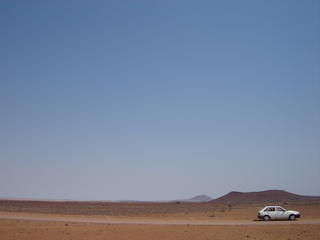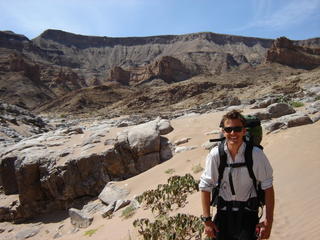The past ten days have been amazing.
I took the bus from Windhoek to Grunau after the brewery tour (unfortunately I had to leave before the tasting session), arriving at 1:30 am. I stayed in a hotel and got up early the next morning to try to hitch a ride to Hobas, where the Fish River Canyon hiking trail starts. I spent all day sitting on the side of the road with some Nama guys (they speak a language with clicks in it). One was trying to hitch a ride, one was his friend, and the third was herding his goats. He would come and chat for a while and then run off to try to round up his goats. In the seven hours we sat there, seven cars passed, and none gave me a ride. Nevertheless, I enjoyed sitting with the guys, asking them about the land, and drawing maps with them of the area.
Finally, at 4 that afternoon I walked back to the petrol station in Grunau (also the hotel) and waited for a truck that comes only on Thursdays to pick up vegetables for a couple of the resorts near Hobas. As it turned out, the back half of the truck was full of people who work for the National Park at Hobas. As we drove to the park, one of them, Amos, suggested that I stay with him.
In Hobas there is an entrance station and a small kiosk, a bathroom, a generator that runs ten hours a day, four employee houses and a house for the park boss. I stayed with Amos (21) and his family (mostly cousins - a total of six kids and the babysitter) who were on holiday from school until September 6. Amos's mother, who is the one who works at the park, was on Holiday in Windhoek.
For the next three days I waited for people to come to the canyon to start the hike so that I could join them. It was great that no one came because I got to stay with the family and learn about the park and generally hang out and learn. Finally a group of four large South African Men in their 60s came to hike the canyon and said I could join them. As we got into the car to get to the trailhead they handed me a cold beer and welcomed me to the group. It was 8:30 in the morning.
The hike itself was quite beautiful, hot, and challenging. A lot of boulder hopping and deep sand. The canyon is smaller than the Grand Canyon and has a lot less water, but was spectacular.
One guy in the group struggled to hike and on the last evening we left him behind thinking he would catch up as previously he had. He didn't. The next morning we made it to Ai-Ais, the end of the hike, and waited for him. In retrospect I should have stayed with him, hiking slowly until he got in. What he didn't tell us was that he was taking a rest day. So, we waited 24 hours then paid some guys from the park to hike up to try to find/rescue him. Meanwhile we worked with the park management to get them to let us drive into the area where we last saw him - the only place in the canyon where you can drive to the bottom also was where he was swimming when we left him. We drove in, I hiked around and we didn't find him.
It was a nerve racking day, and I was quite filled with guilt. Simply put, I should have known better, and should have hiked with him. No excuses, I knew better. Finally, mid day, he made it to Ai-Ais with the help of the guys we hired.
It was quite a relief. The upside is that I learned a good lesson: even if I am not the trip leader and I am just joining the group, I have the skills and knowledge to stay with someone and see them to the end safely. That is far better than leaving them to their own devices and having to use search and rescue. The other upside is that I got to know how the search and rescue system works in the canyon.
After that, I got a ride back to Grunau, ate two hamburgers there that have since made me sick, and got on the overnight bus back to Windhoek.
A few concluding thoughts:
- There is a huge need for a better hiking map for the canyon.
- Search and rescue needs to be revised from the policy of "wait 24 hours" to go when needed. There also need to be more skilled and prepared people at the canyon for this purpose.
- The people who work at Hobas have almost no relationship to the canyon or the land. Most of them are there because it is a pretty easy, good paying government job.
- The Namibia Wildlife Resorts and the Ministry of Environment and Tourism run the canyon (NWR the campsite at Hobas and resort at Ai-Ais and MET the canyon itself and entrance fees). These should be run under the same government agency. It would streamline things, and allow fees to go the improvement/maintenance of facilities.
- A more expansive Leave No Trace program would be great in the canyon. There are a lot of cigarette ends and toilet paper on the hike.






